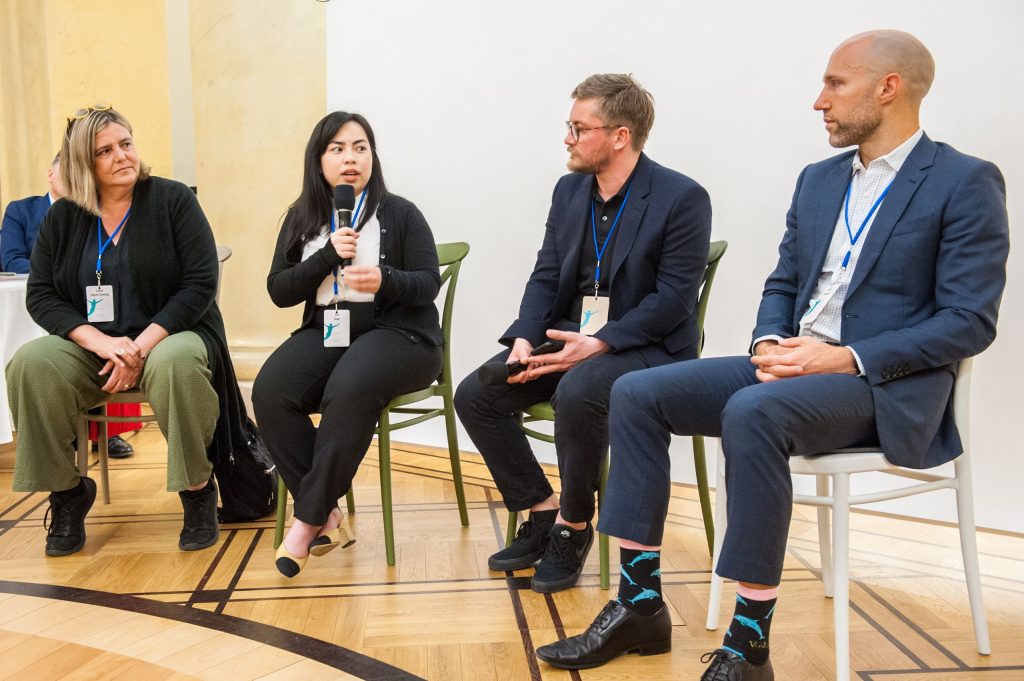This panel at the Democracy Technology Convention was curated by Participation Factory and brought together three experts with a wealth of experience in participation.
Isabel Xavier Canning is a director at the City of Cascais in Portugal, which has been implementing participatory budgeting successfully for years. Van Doan is a Senior Executive at Decision 21 in the Czech Republic, a digital platform that works to improve collective decision-making. Matt Stempeck is the curator of the Civic Tech Field Guide in the US, the most extensive catalogue of projects that use technology for the common good.
Together, the panellists explored how governments can best approach participation, how technology can help, and what makes a participation project successful.
Building the participation habit: A systematic approach
Participation is not only a means to engage citizens but also a way to restore trust in democracy. As Isabel Xavier Canning points out, people “believe in democracy, but they don’t believe in politicians”. Participation can bridge this gap by making citizens feel involved and taken seriously.
At the same time, governments should not see participation as a one-stop solution: “Don’t just decide to [start a participation project] because you’ve seen elsewhere that it will give you votes”, warns Isabel. Matt Stempeck agrees that “there should not be participation for participation’s sake alone”.
Truly committing to participation involves systematically changing your community’s decision-making behaviours, the panellists concur. It helps to recognise that “democracy is an ongoing habit that you have to cultivate at all times”, says Van Doan.
Isabel believes that a sustained effort is necessary for participation to be successful: “You need […] everybody together thinking about participation. It needs to be a strategy added to every government team. If you are part of the city planning team, how can you include participatory elements? If you work in education, how can citizens be involved?”
There is also discussion of the importance of being attuned to your citizens’ needs, as people’s willingness to be engaged depends on their preferences and resources. Technology can provide simpler avenues for participation and make it more accessible.
Whether your participatory project involves technology or not, citizens must learn the skills they need to become involved. Offering workshops to your citizens can prepare them for your participation project. Van Doan explains that in her work with Decision 21, they engage children from a young age: “We try to draw them in as soon as they can read and explain how democracy and voting work,” she says. An endeavour which helps cultivate participation from childhood onwards.
Technology in participation
Technology can be a crucial tool in participatory processes, but its role is constantly evolving. As curator for the Civic Tech Guide, Matt has a comprehensive overview of the various technological tools that can support participatory efforts. “Technology can do quite innovative stuff. AI, for example, can help two opposing sides in an argument help find consensus”, he illustrates.
At the same time, he knows that tools don’t need to be sophisticated. Several panellists have found that tools tend to work best when they are efficient and adaptable to the needs of the participatory process.
“In civic tech, distribution and marketing are the biggest challenges”, Matt explains. Meaning that making the technology as accessible as possible within the context it is applied will increase its likelihood of success. Van notes that making a technology accessible also includes adding multiple language options in multilingual spaces and other inclusivity measures.
Isabel also stresses that it’s important to deal with the evolution of the technology: “It makes no sense if, say, five years after starting your participatory process, you’ve changed how you work with people but haven’t changed the technology”.
Measuring success
Measuring the success of participatory initiatives involves more than just the number of participants. “We have very impressive numbers. In our town of 206,000 people, 70,000 participate in participatory budgeting”, Isabel says. But numbers do not fully capture the impact of the project.
While numerical values can facilitate valuable insights, “people are inherently experiential”, Matt emphasises. “Their lived experience sticks with them the most”.
The panellists all found that to get people excited about participation and build positive memories about it, it is crucial to provide them with the experience of making a difference in their community.
